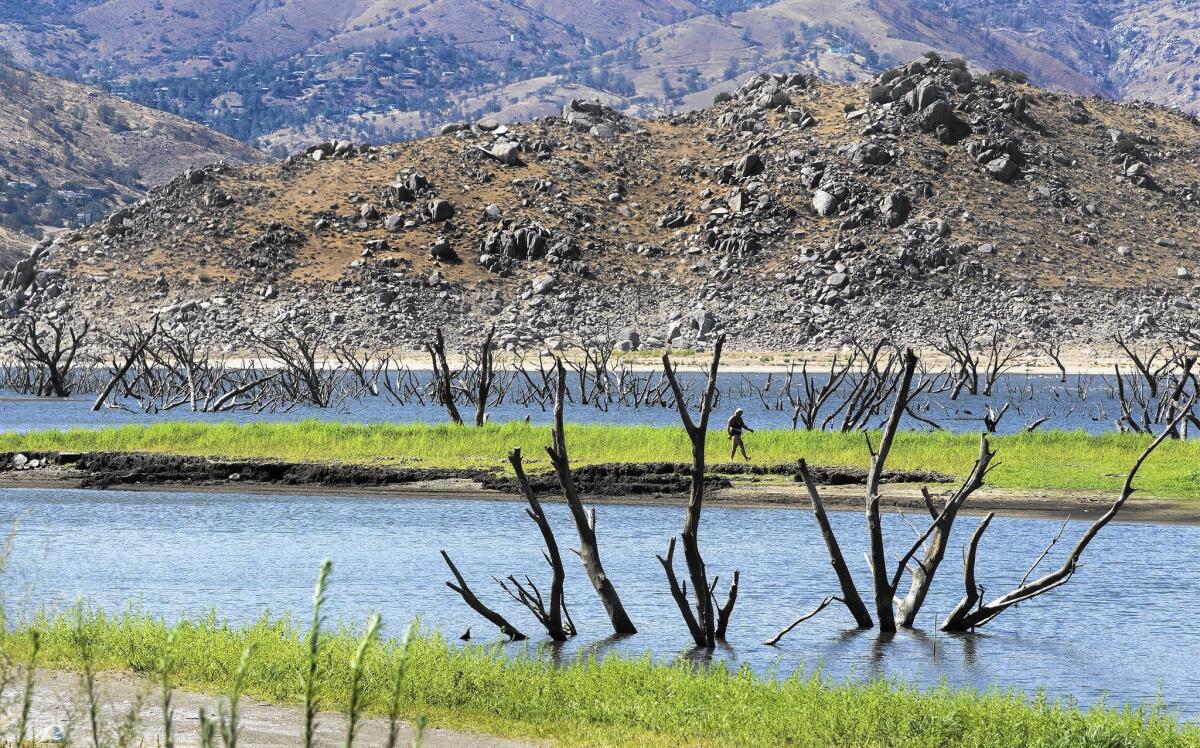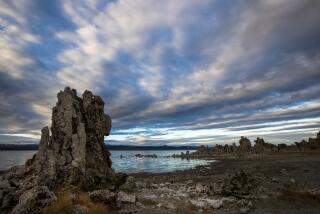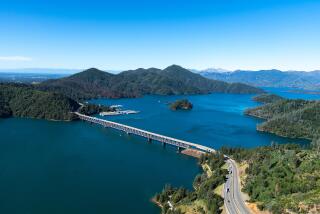Treasures revealed as California drought drains lakes

LAKE ISABELLA, Calif — The Lakeview Motel’s name is false advertising these dry days.
The same thing is true for the Paradise Cove Lodge down California 178.
That’s because the water level in man-made Lake Isabella has dropped about 59 feet since the last big wet year in 2011. There are 32,632 acre-feet of water in the lake — 5.8 % of the lake’s capacity, according to the U.S. Army Corps of Engineers.
The water level is low enough that dozens of ghostly white cottonwood trees at the bottom of the lake have emerged from the water.
The gangly arms of the barren trees are a once-in a-generation view.
“You see this all over the West,” said Jon Christensen, a historian with UCLA’s Institute of Environment and Sustainability. “It is an eerie way of revealing both our history and our possible fate.”
Tourists are flocking to the old Mormon settlement of St. Thomas, which was inundated by Lake Mead when the Hoover Dam was built and has slowly revealed itself in recent years.
Levels at that lake are low enough that the National Park Service this year started issuing permits for divers to visit a B-29 bomber that crashed into the lake in 1948. Now, the wreckage of the plane is 100 feet underwater, park spokeswoman Christie Vanover said.
The roads leading to three submerged towns beneath Lake Oroville are being slowly exposed as well, said Mike Hubbartt, a state park interpreter at the lake. Officials are checking to make sure hikers don’t steal old artifacts there, he said.
Then there is the case of the federal agent who in 1992 spent a fateful day of boating at Castaic Lake.
A friend put all his belongings — including his police gear and gun — into a backpack that fell overboard and sank to the bottom of the lake.
Last fall, with water receding rapidly from the lake, a fisherman found the agent’s gear — including his badge, gun, an old pager and a mini-calendar from 1992.
In many ways, unearthing the past is a ritual of the drought cycle.
During the severe drought of 1991, the receding water revealed gold mining and railroad equipment, stolen cars and even some skeletons. At several lakes, including Folsom and Berryessa, what was left of long-ago flooded towns came to the surface.
Many reservoirs inundated prime real estate such as old ranches, settlements and Native American sites, said Douglas Dodd, a history professor at Cal State Bakersfield.
He found an arrowhead on the shores of Huntington Lake in Fresno County when he visited last summer. He also discovered a 1970s-style jogging shoe and rusted cans of beer made before the days of pop-tops.
At Lake Isabella, the cottonwoods may be left from the old ranches along the Kern River or homes from the original site for Kernville that was flooded to create the lake, Dodd said.
A few of the visible treetops are arranged in straight lines as if they mark old property boundaries or streets.
It is also possible the trees were put there as the dam was being built to help create habitat for bass, Army Corps spokesman Tyler Stalker said.
Regardless of the trees’ origins, watching small fishing boats wind past the tall trees popping out of the lake was an eerie sight for Dale Baker, who was at the lake with his dog Sarah.
The 53-year-old Bakersfield fisherman has been coming to the lake for 20 years.
“Never seen the trees before,” he said, casting a line from the south side of the lake. “We get another year of drought and you will be able to walk clear across the lake.”
Water and Power is The Times’ guide to the drought. Sign up to get the free newsletter >>
Lake Isabella has seen its ups and downs since it was created in 1953 when the Army Corps dammed the Kern River, but this drought is among the worst.
In a good year, the water in Lake Isabella comes up to the edge of a campsite across the two-lane highway from the Paradise Cove Lodge.
Looking out at the lake from the lodge parking lot Tuesday, owner Pam Smith couldn’t even see water. All that was visible was hundreds of yards of yellow grass that slowly gave way to greener patches..
Smith, 61, said the water hasn’t been this low in three decades. And it’s hurting the usually brisk summer business. The small tourist towns around Lake Isabella, with their 1950s roadside attraction ambience and neon signs, are relatively quiet these days.
“I haven’t seen one Jet Ski in the parking lot all year,” she said.
Over the last 20 years, the lake has held an average of 234,429 acre-feet at this point in August, according to Army Corps records.
The last big wet year was 2011 when the lake had 334,711 acre-feet at this point.
The lake can hold 568,000 acre-feet but the Army Corps has put the limit at 361,000 acre-feet because the twin dams that form the lake are considered to be among the most at risk in the nation, Stalker said.
The Kern Canyon fault runs under the dams, which have also dealt with seepage problems and face the risk of overtopping in a catastrophic flood.
This is not the first time Lake Isabella has given up some history.
Plunging water levels revealed the foundations of buildings from Old Kernville, the original hub for the Kern Valley, at the edges of the lake. The town site, originally named Whiskey Flat, was founded in 1860 after prospectors found gold in the nearby hills.
The old Wild West town was the site of an 1863 massacre of 35 Tubatulabal and Kawaiisu Indians by the U.S. cavalry. Later, the town became known for the westerns that were filmed there, including 1939’s “Stagecoach” staring John Wayne.
Leaning against a pickup truck during his first visit to the lake, Baker’s friend Mark Blackledge looked out at the trees and rubbed his head.
The men were among the few people fishing Tuesday. In the distance, a lone Jet Ski could only go a short distance before facing sand, rocks or trees.
“You used to be able to Jet Ski right over these trees,” Baker said in disbelief.
Bob Jamison, owner of the Lakeview Motel, has seen the lake rise and fall in the last 30 years. He is hoping the expected El Niño will restore the lake this fall.
Until then, he doesn’t plan to change the name of his motel, although he admits that he has thought about it.
“Several times,” he chuckled.
Twitter: @jpanzar
Hospitals look for ways to cut water use
Heat and drought devastate sockeye salmon fishing and spawning on Washington rivers
Trickle-down politics: Drought could force real change among city, state leaders
More to Read
Sign up for Essential California
The most important California stories and recommendations in your inbox every morning.
You may occasionally receive promotional content from the Los Angeles Times.











